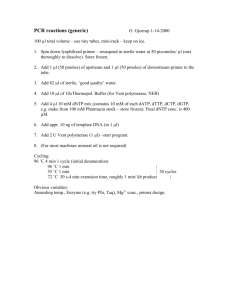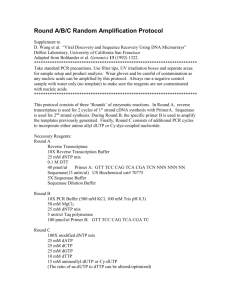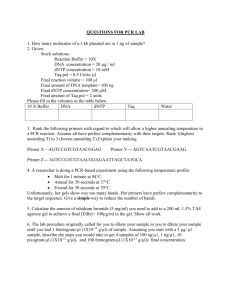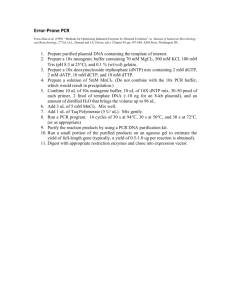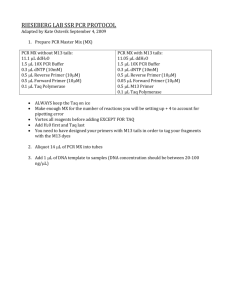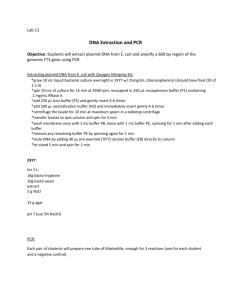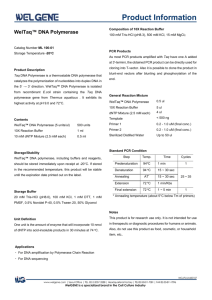DNA amplification
advertisement
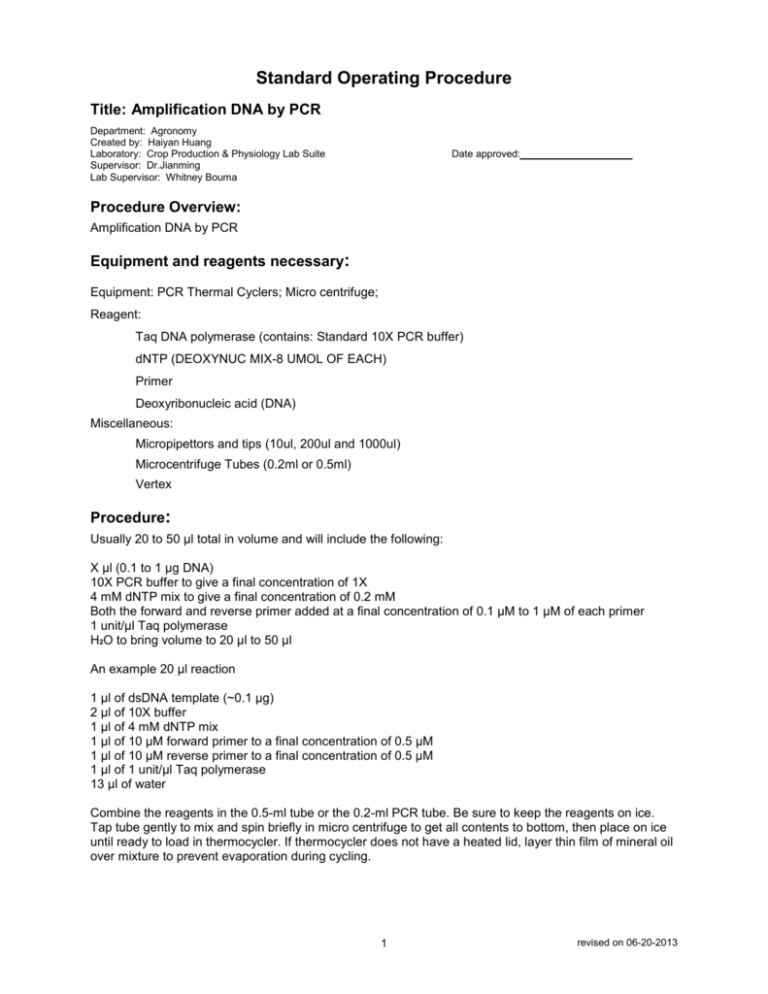
Standard Operating Procedure Title: Amplification DNA by PCR Department: Agronomy Created by: Haiyan Huang Laboratory: Crop Production & Physiology Lab Suite Supervisor: Dr.Jianming Lab Supervisor: Whitney Bouma Date approved: Procedure Overview: Amplification DNA by PCR Equipment and reagents necessary: Equipment: PCR Thermal Cyclers; Micro centrifuge; Reagent: Taq DNA polymerase (contains: Standard 10X PCR buffer) dNTP (DEOXYNUC MIX-8 UMOL OF EACH) Primer Deoxyribonucleic acid (DNA) Miscellaneous: Micropipettors and tips (10ul, 200ul and 1000ul) Microcentrifuge Tubes (0.2ml or 0.5ml) Vertex Procedure: Usually 20 to 50 μl total in volume and will include the following: X μl (0.1 to 1 μg DNA) 10X PCR buffer to give a final concentration of 1X 4 mM dNTP mix to give a final concentration of 0.2 mM Both the forward and reverse primer added at a final concentration of 0.1 μM to 1 μM of each primer 1 unit/μl Taq polymerase H2O to bring volume to 20 μl to 50 μl An example 20 μl reaction 1 μl of dsDNA template (~0.1 μg) 2 μl of 10X buffer 1 μl of 4 mM dNTP mix 1 μl of 10 μM forward primer to a final concentration of 0.5 μM 1 μl of 10 μM reverse primer to a final concentration of 0.5 μM 1 μl of 1 unit/μl Taq polymerase 13 μl of water Combine the reagents in the 0.5-ml tube or the 0.2-ml PCR tube. Be sure to keep the reagents on ice. Tap tube gently to mix and spin briefly in micro centrifuge to get all contents to bottom, then place on ice until ready to load in thermocycler. If thermocycler does not have a heated lid, layer thin film of mineral oil over mixture to prevent evaporation during cycling. 1 revised on 06-20-2013 Personal Protective Equipment / Engineering Cont rols: Nitrile gloves Safety glasses Face shield Dust mask Latex gloves Splash goggles Lab coat Fume hood Neoprene gloves Vented goggles Apron Biosafety cabinet Insulated gloves Eye wash station Safety shower Respirator Note: Open-toed and heeled shoes are NOT allowed. Other Control Measures: Handling & Storage Precautions: DNA: Store at -20oC upon receipt in an appropriately labelled container. Taq polymerase: Store at -20oC upon receipt in an appropriately labelled container. 10X buffer: Store at -20oC upon receipt in an appropriately labelled container. dNTP: Store at -20oC upon receipt in an appropriately labelled container. Primer: Store at -20oC upon receipt in an appropriately labelled container. Waste Disposal Procedures: Unless EH&S specifically instructs otherwise, all chemical/reagent waste (including excess solutions) must be placed in an appropriately labeled hazardous waste container for EH&S disposal. Compatible substances may be combined into one waste container. Spill/Release Containment and Clean Up/Decontamination Procedures: Taq polymerase: Absorb spill with inert material (e.g. vermiculite, sand or earth), then place in suitable container. Avoid runoff into storm sewers and ditches which lead to waterways. Clean up spills immediately, observing precautions in the Protective Equipment section. Provide ventilation. 10X buffer: Soak up with an inert absorbent material. dNTP: Soak up with an inert absorbent material. Primer: Soak up with an inert absorbent material. Health & Safety Summary for Required Reagents: 10X buffer:May cause irritation to eyes. May cause irritation to eyes. There is no MSDS available for Primer, so there should not be any significant health or safety risks associated with this material. 2 revised on 06-20-2013 C a r c i n o g e n T e r a t o g e n M u t a g e n Chemical name Taq polymerase dNTP 10X buffer R e p r o d u c t i v e E f f e c t s S e n s i t i z e r I r r i t a n t T o x i c H i g h l y C o r r o s i v e T o x i c C o m b u s t i b l e C o m p r e s s e d G a s Target Organ(s) E x p l o s i v e F l a m m a b l e O r g a n i c P e r o x i d e s O x i d i z e r P y r o p h o r i c U n s t a b l e W a t e r H e a l t h F l a m m a b i l i t y R e a c t i v i t y 0 0 1 0 0 0 0 0 0 0 0 0 R e a c t i v e Incompatibilities Oxidizing agents Skin, eyes, respiratory tract Primer The above summary consists of guidelines for proper handling & disposal of chemicals used in this procedure. You must read and understand the contents of the entire MSDS(s) before starting this procedure. References: 3 revised on 06-20-2013
